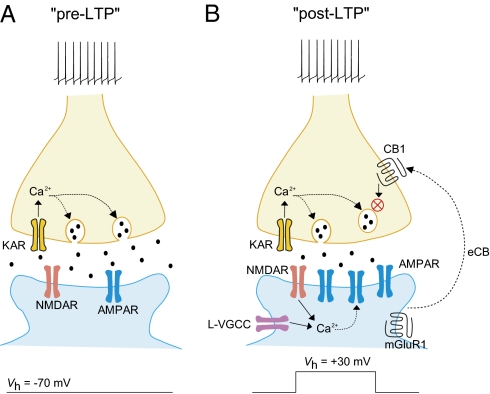Fig. 6.
Potential mechanisms of suppression of pre-LTP by the induction of post-LTP at thalamo-LA synapses. (A) Stimulation of thalamic input to the LA with paired pulses at 2 Hz frequency for 2 min without postsynaptic depolarization leads to the induction of LTP, which is both induced and expressed presynaptically (pre-LTP). This form of LTP depends on activation of presynaptic GluR5 subunit-containing kainate receptors and presynaptic Ca2+ influx. (B) Delivery of the identical presynaptic stimulation, but under conditions of postsynaptic depolarization to +30 mV, results in a form of LTP that is both induced and expressed postsynaptically (post-LTP). The induction of post-LTP depends on postsynaptic Ca2+ influx through NMDA receptors and L-type voltage-gated Ca2+ channels. Therefore, two mechanistically distinct forms of LTP coexist in thalamic input, but pre-LTP is suppressed by the induction of post-LTP at the same synapses. The observed interaction between coexisting forms of LTP in inputs to the LA may be mediated by activation of presynaptic CB1 receptors by eCB released in response to activation of the mGluR1, thus preventing the long-term enhancements of neurotransmitter release observed during pre-LTP.

